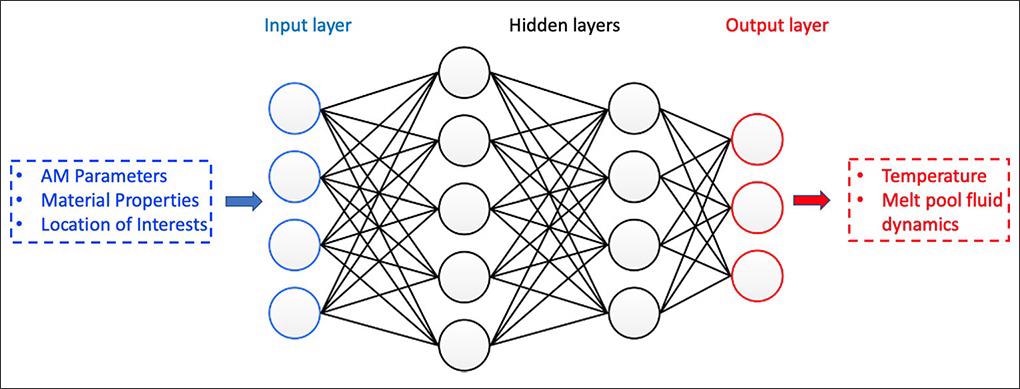Jul 2 2021
Additive manufacturing can help make products or parts on-demand in automotive engineering, manufacturing and even in outer space.
 A fully connected deep neural network for metal additive manufacturing. Image Credit: Texas Advanced Computing Center.
A fully connected deep neural network for metal additive manufacturing. Image Credit: Texas Advanced Computing Center.
Yet,it is difficult to know the performance of a 3D-printed object currently and in the future. Physical experiments, particularly for metal additive manufacturing (AM), are expensive and slow. Modeling such systems computationally is costly and laborious.
The problem is multi-phase and involves gas, liquids, solids, and phase transitions between them. Additive manufacturing also has a wide range of spatial and temporal scales. This has led to large gaps between the physics that happens on the small scale and the real product.
Qiming Zhu, PhD Student, University of Illinois
Zhu, Zeliang Liu (working as a software engineer at Apple), and Jinhui Yan (professor of Civil and Environmental Engineering at the University of Illinois) have been making efforts to tackle these difficulties with help of machine learning.
They have been using deep learning and neural networks to forecast the results of complicated processes that are involved in additive manufacturing.
“We want to establish the relationship between processing, structure, properties, and performance,” stated Zhu.
Existing neural network models would require huge amounts of data for training. However, in the additive manufacturing field, achieving high-fidelity data is hard, feels Zhu. To decrease the necessity for data, Zhu and Yan are following 'physics informed neural networking,' or PINN.
Zhu added, “By incorporating conservation laws, expressed as partial differential equations, we can reduce the amount of data we need for training and advance the capability of our current models.”
Zhu and Yan used the National Science Foundation-supported Frontera and Stampede2 supercomputers at the Texas Advanced Computing Center (the #10 and #36 fastest in the world, as of June 2021) to simulate the dynamics of two standard experiments: an example of laser beam melting tests taken from the 2018 NIST Additive Manufacturing Benchmark Test Series and an example of 1D solidification, when solid and liquid metals interact.
In the 1D solidification example, the researchers input the data obtained from experiments into their neural network. As part of the laser beam melting tests, experimental data together with results from computer simulations were utilized.
The researchers developed a 'hard' enforcement technique for boundary conditions, which they consider is equally significant in problem-solving.
The neural network model of the group could recreate the dynamics of both experiments. As far as the NIST Challenge is concerned, it estimated the temperature and melt pool length of the experiment within 10% of the real results. The model was trained on data obtained from 1.2 to 1.5 μs and estimates were made at further time steps up to 2.0 μs.
The study findings were published in the journal Computational Mechanics in January 2021.
This is the first time that neural networks have been applied to metal additive manufacturing process modeling. We showed that physics-informed machine learning, as a perfect platform to seamlessly incorporate data and physics, has big potential in the additive manufacturing field.
Qiming Zhu, PhD Student, University of Illinois
Going forward, Zhu envisions engineers making use of neural networks as quick prediction tools to offer guidance on choosing the parameter for the additive manufacturing process — for example, the laser’s speed or the temperature distribution — to map the relationships between additive manufacturing process parameters and the properties of the ultimate product, for example, its surface roughness.
“If your client requires a specific property, then you'll know what you should use for your manufacturing process parameters,” stated Zhu.
In another paper published online in the journal Computational Methods in Applied Mechanics and Engineering in May 2021, Zhu and Yan put forward an alteration of the current finite element method framework employed in additive manufacturing to verify whether their method could achieve improved predictions over current standards.
Simulating a new additive manufacturing experiment from Argonne National Lab in which a laser is moved, the team demonstrated that simulations executed on Frontera varied in-depth than those in the experiment by below 10.3% and captured the usual experimentally-observed chevron-type shape on the top surface of the metal.
Zhu and Yan’s study benefits from the ongoing development of computing technologies and federal investment in high-performance computing.
Apart from accelerating studies like theirs, Frontera also paves the way to machine and deep learning studies in fields where training data is not extensively available, thus widening the potential of AI-based research.
The most exciting point is when you see that your model can predict the future using only a small amount of existing data. It's somehow learning about the evolution of the process. Previously, I was not very confident on whether we'd be able to predict with good accuracy over temperature, velocity, and geometry of the gas-metal interface. We showed that we're able to make nice data inferences.
Qiming Zhu, PhD Student, University of Illinois
Journal Reference:
Zhu, Q., et al. (2021) Machine learning for metal additive manufacturing: predicting temperature and melt pool fluid dynamics using physics-informed neural networks. Computational Mechanics. doi.org/10.1016/j.cma.2021.113910.
Source: https://www.tacc.utexas.edu/